
Calculating Excavation Slopes, Swell Factors, & Fill Material
Excavation Slope
Example: This example shows an excavation with an average depth of 10'. A 1/2:1 slope means the excavation must be sloped 1/2 unit for each 1 unit of depth. For a 10' depth the slope will extend within 5' of the edge of the excavation. A 1:1 required slope with slope to 10' of the edge of where the average depth begins.
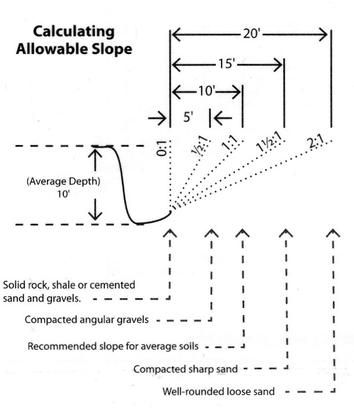
NOTE: Required Slopes are based on soil type and is regulated by OSHA. Before you calculate dirt to be excavated, you must identify the soil type and determine the required slope.
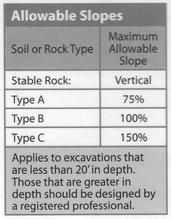
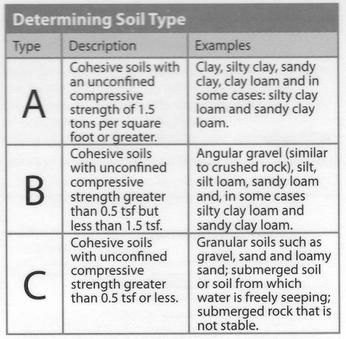
Calculating Excavations

Example: Calculate the CYs of Dirt to be removed from an excavation that is 20' by 35'. The soil type is A.
- If the average depth is 12'; the slope must extend 75% outward from the beginning of where the 12' begins. (based on chart slope is 3/4:1) 75% of 12 = 8.
- Add the length at the top of the excavation to the length at the bottom of the excavation and divide by 2 to get the average length. Do the same for the width.
- Multiply the average length times the average width times the average depth and divide by 27,

NOTE: Swell factor has not been considered in this example.
Swell Factors
Calculate the Swell Factor
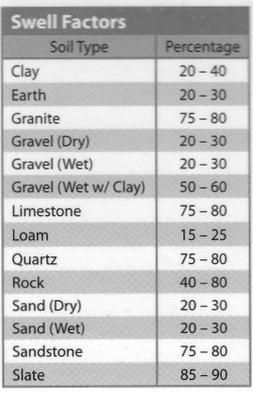
- Determine the amount of soil to be excavated.
- Identify the soil type.
- If not supplied by an engineer, choose the higher range of the swell factor supplied.
- Add the percentage to the net soil to be excavated.
Example: What is the total amount of soil to haul away if the excavation is 200 cubic yards of wet gravel?
- 200 CYS
- Wet Gravel
- 30%
- 200 + 30% = 260 Cubic Yards
NOTE: You must add a percentage to the excavated area to account for the "swell." The amount is based on the soil type.
Estimating Fill Material
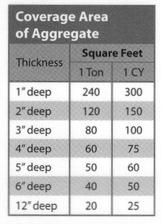
- Calculate the volume (in Cubic Feet - L x W x D) of the area for which you need fill material.
- If the material is ordered by the yard, divide the CF by 27.
- If the material is ordered by the ton, identify the weight per CF of the material and multiply it out. Next, divide by 2000 to convert the weight to tons.
- You man need to add a percentage to account for swell if you need to fill in an excavation.
NOTE: Gravel can have different densities (weight)
NOTE: This table is based on the common "Aggregate" Weight of 100lbs per CF
Using the Table
Example: How many tons of gravel will be needed for an area that is 20' wide, 100' long to be 2" deep?
- 20 x 100 = 2,000 SF
- 2" Deep, 1 ton will cover 120 SF (see table)
- 2,000 ÷ 120 = 16.67 tons
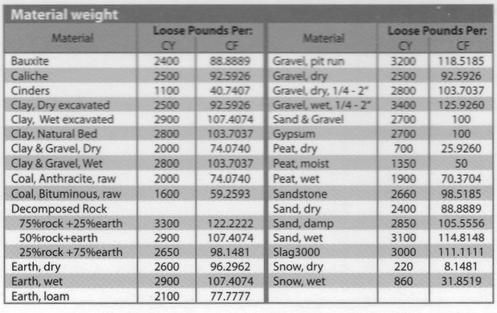
Guidelines for Uniform Temporary Marking of Underground Facilities
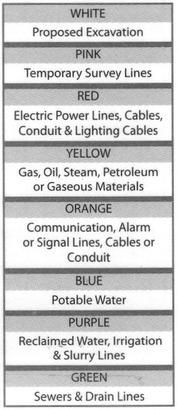
- One-Call Systems -The One-Call damage prevention system shall be contacted prior to excavation.
- Proposed Excavation - Use white marks to show the location, route or boundary of proposed excavation. Surface marks on roadways do not exceed 1.5" by 18" (40 mm by 450 mm).The facility color and facility owner identity may be added to white flags or stakes.
- Use of Temporary Marking - Use color-coded surface marks (i.e., paint or chalk) to indicate the location or route of active and out-of-service buried lines. To increase visibility, color coded vertical markers (i.e., stakes or flags) should supplement surface marks. Marks and markers indicate the name, initials or logo of the company that owns or operates the line, and width of the facility if it is greater than 2" (50 mm). Marks placed by other than line owner/operator or its agent indicate the identity of the designating firm. Multiple lines in joint trench are marked in tandem. If the surface over the buried line is to be removed, supplementary offset markings are used. Offset markings are on a uniform alignment and clearly indicate the actual facility is a specific distance away.
- Tolerance Zone - Any excavation within the tolerance zone is performed with non-powered hand tools or non-invasive method until the marked facility is exposed. The width of the tolerance zone may be specified in law or code. If not, a tolerance zone including the width of the facility plus 18" (450 mm) measured horizontally from each side of the facility is recommended.
- Adopt Uniform Color Code -The APWA encourages public agencies, utilities, contractors, other associations, manufacturers and all others involved in excavation to adopt the APWA Uniform Color Code, using ANSI standard 2535.1 Safety Colors for temporary marking and facility ID
Use This Menu to Locate More Tips for Everyday Math
- Calculating for Contractors (Estimating Tips, Mark up & Gross Profit)
- Calculating Area & Volume for Geometric Shapes
- Calculating & Estimating Concrete Slabs & Masonry Blocks
- Calculating Brick, Concrete, Footers and Mortar
- Calculating Paint & Wallpaper
- Calculating Roofs & Gables (Waste Factors, Felt, Shingles, Nails, Etc.)
- Calculating Wall Studs, Drywall, Ready Mix, Tape, Joint Compound, Nails & Screws
- Calculating Wall Tile & Floor Tile
- Calculating Stairs, Stair Runs, Risers & Stair Terminology
- Calculating Slopes, Soil, Fill Material, Excavation Tips & Color Code for Underground Lines